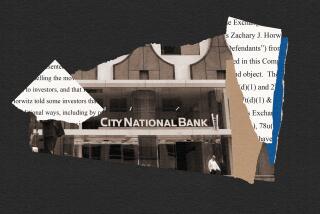VIEWPOINTS : Rescue of S&Ls; Huge Burden for Taxpayers
- Share via
The last time the Federal Home Loan Bank Board tried to rescue American Savings & Loan, the bet was that an experienced banker could make the thing profitable by out-guessing the market on where interest rates were heading. Instead of using customers’ deposits to make loans and write mortgages, American Savings would leverage the money by repurchase agreement with the Wall Street houses, to carry collateralized mortgage obligations (CMOs) that normally pay higher rates.
This strategy necessarily involved making the S&L; bigger whenever management thought rates were going to head down. Such expansion is a cinch in an age when the federal government will insure both principal and interest on all deposits, however high management bids up its advertised rate. But a depository that has to pay more than the rates offered by other S&Ls; is not really likely to be a Phoenix or a Cinderella or whatever other cute names the bank board coined for its lame ducks. It’s going to be a drag, and the larger it gets, the more money it is likely to lose.
Thrift industry consultant Bert Ely reports that outside Texas, where most of them are more or less sound, federally insured thrifts in the period 1982-87 grew 56%. In Texas, where many of them were thoroughly unsound, the growth rate was 148%. Financial Corp. of America, American Savings’ parent, bounced up and down, because every so often the bank board got nervous and ordered management to sell some of its holdings. But, at $31 billion, it is at least twice as big as it should have been.
The ‘Never-Never’
Indeed, the thrift that is supposed to emerge finally from the new reorganization--owned 70% by the investors lead by Texan Robert M. Bass and 30% by the government through the Federal Savings & Loan Insurance Corp.--will be only about $15 billion in total assets.
FSLIC is putting $2 billion into this rescue, which is pretty funny--you and I are closer to having $2 billion than FSLIC is, because FSLIC already owes about $14 billion that it has no way to pay. But the Treasury is encouraging FSLIC to make such grandiose gestures this month. After Oct. 1, the government will have to count FSLIC losses as part of the federal deficit, but for the rest of this month it’s still on what the British call the never-never.
In fact, we don’t know and FSLIC doesn’t know how much the government will have to sink into American Savings & Loan. Presumably, the $550 million the Bass interests are putting in, plus the $250 million FSLIC has found somewhere for the first piece of its promised assistance, will bring the S&L;’s net worth back up to zero (or to 4%, if you want to believe “regulatory accounting”).
But the $15 billion to $16 billion of paper to be dumped into a new “bad bank” of assets the Basses don’t want are going to generate losses of unknown dimensions. FSLIC continues on the hook for these losses, because it continues to guarantee any and all lenders to American Savings. And the bank board last month dropped its requirement that the owners of a thrift reorganized with FSLIC assistance keep enough of their own money in it to maintain some kind of net worth, so in the future losses will splat onto FSLIC’s head even quicker.
The FCA portfolio has already been stripped of salable and profitable holdings to make the thrift’s losses look less bad. Among the more remarkable accounting practices sanctioned by the bank board has been a system whereby S&Ls; have been permitted to carry at historic cost assets that today can be sold only at a loss, while taking profits when they sell off assets at more than the price they paid.
Deal Will Go Sour
This time around, the bank board is gambling on a new strategy. Relying on laws that give “service corporation” subsidiaries of S&Ls; much greater powers than any bank or bank holding company enjoys, the bank board has authorized the Bass Group to use deposits in American Savings & Loan as funding for takeover and buyout deals in which their investment banking group has an interest. If that business goes suddenly sour--and one of these days it will, sure as God made green apples--the taxpayer will be stuck with the losses.
This, obviously, is a case for SuperCongress, the great investigator from outer space, but unfortunately Congress is the real villain. Sick thrifts grow bigger only because in the Garn-St Germain Act in 1982, Congress structured this nutty procedure by which brokered deposits flow to improper, perilous or even crooked uses. As early as October, 1983, when he had been in office less than six months, bank board Chairman Edwin Gray warned the House Banking Committee of the need to “revisit the whole matter of what federal deposit insurance is and what it ought to be used for.”
Instead, an actual majority of the House signed a petition warning Gray and his colleague William Isaac at the Federal Deposit Insurance Corp. that nothing in the law entitled them to interfere with the flow of brokered funds to insured institutions. Congress responded not to public needs but to pressure from contributors in the S&L; industry and the big Wall Street brokerage firms that were making a bundle in commissions on this dubious business.
Even now, with credible authority arguing that FSLIC is losing a billion dollars a month of what will someday be taxpayer’s money--and with all sorts of legislation pending that involve banks and bank regulation--Congress is hiding from the problem. Nothing to restrict brokered deposits or limit deposit insurance or restore control over the asset powers of insured institutions is so much as on the table. One of the questions voters should ask their congressmen this fall is whether they signed that petition to the regulator four years ago, and thus abetted a financial services industry scam that looks likely to cost their real constituents $60 billion. For nothing. Or maybe to make the Bass family richer still.
More to Read
Inside the business of entertainment
The Wide Shot brings you news, analysis and insights on everything from streaming wars to production — and what it all means for the future.
You may occasionally receive promotional content from the Los Angeles Times.









